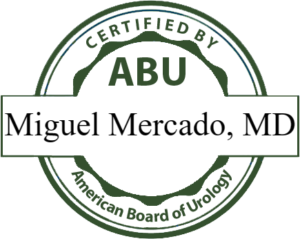Cystoscopy Procedure in The Woodlands, TX
A cystoscopy is an endoscopic procedure used to examine the internal state of the urethra and lining of the bladder. This procedure is typically performed to investigate concerning symptoms of the urinary system that are unable to be diagnosed through more traditional imaging tests such as an X-ray.
Urologist Miguel A. Mercado, MD is board-certified by the American Board of Urology and has extensive experience performing safe and effective cystoscopies. If you’re in need of a cystoscopy in the Houston area, call our office at (281) 351-5174 today to schedule an appointment in The Woodlands or Tomball.
What Is the Purpose of a Cystoscopy?
Dr. Miguel Mercado commonly performs cystoscopies to accurately diagnose a patient’s symptoms that are likely caused by a condition of the urethra or bladder, including:
- Urinary incontinence
- Bladder stones
- Benign prostatic hyperplasia (BPH), which is also known as an enlarged prostate
- Tumors of the bladder
- Urinary tract infection (UTI)
- Overactive bladder
- Inflammation of the bladder (cystitis)
- Hematuria (blood in the urine)
- Bladder cancer
All of the conditions mentioned will become much more aggressive over time if left untreated, which will lead to worsening symptoms such as loss of control over the bladder, sepsis, or even death. To prevent such an extreme outcome, it is much better for the patient and their long-term health to diagnose the cause of their discomfort as soon as possible.
What Happens During and After a Cystoscopy?
To begin this procedure, a small tube called a cystoscope is inserted into the patient’s urethra. Inside this tube exists a camera that transmits images from inside the urethra and bladder to a monitor in front of Dr. Mercado so that they can clearly see these internal organs.
This instant visual allows the urologist a chance to assess the tissues of the urethra and bladder, and hopefully determine a direct source of their patient’s symptoms. Dr. Mercado is also likely to fill the bladder with a sterile solution to improve their view and provide a more accurate diagnosis. Some patients already determined to have bladder stones may have them removed during a cystoscopy, or it is also possible for a tissue sample to be taken for further testing after the procedure is complete if your urologist suspects that these tissues may be cancerous.
Patients may either be numbed or fully sedated during a cystoscopy. The procedure is known to be somewhat painful, as the placement of the cystoscope into the urethra can cause some discomfort. This generally results in soreness that subsides gradually in the days following your cystoscopy. You may also notice a mild burning sensation when you urinate, though this is also a perfectly normal side effect of the procedure.
Rare, Yet Serious Signs of a Complication
As with any procedure, there are a small number of risks associated with a cystoscopy. If you begin to notice any of the following symptoms after your endoscopic assessment, please contact Dr. Mercado immediately for early intervention:
- You’re unable to urinate
- You have a fever of 101.4 F or higher
- You get the chills
- There are large amounts of blood or blood clots in your urine
- You experience pain in your chest
- You become nauseous
- While urinating you notice intense pain that lasts for more than two days
When Will My Cystoscopy Results Be Ready?
Depending on the particular patient and their physician, some individuals may be consulted about their cystoscopy results immediately after it is over. Others, especially those that have been under general anesthesia during their procedure, will be given their results later on. Dr. Mercado may also need to wait until additional testing has been finished on any samples that may have been taken during your cystoscopy.
Schedule a Consultation for a Cystoscopy in Tomball Today!
Dr. Miguel Mercado specializes in performing cystoscopies for the diagnosis of a variety of urinary conditions. To schedule a consultation in Tomball or The Woodlands, call us at (281) 351-5174.





